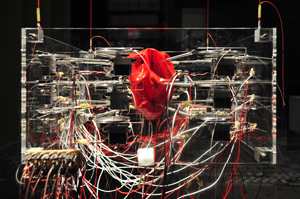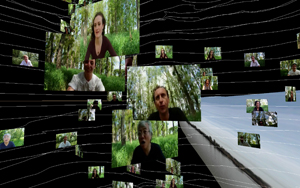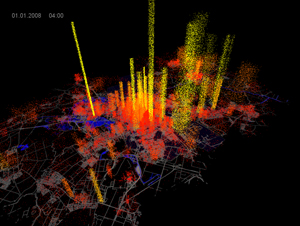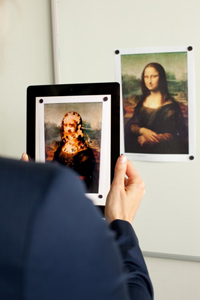Database aesthetics visualized at the 8th Digital Art Festival Taipei
By Gloria Cho Planned under the umbrella theme of "Data-Neurons," the festival seeks to combine two crucial ideas: "Big Data" and "Neurons" within our contemporary global network society. The two concepts imply that, like human neurons, massive amounts of data trigger and interact with one another in real-time. This phenomenon has tremendously changed the dimensions of economy, politics, media, and culture in our society. "Through the visualization of behind-the-scenes digital operation, we'll be able to see the extreme of aesthetics of database," said Curatorial Chih-Yung Aaron Chiu, Mass Communications Professor at Providence University during the Nov. 14 opening ceremony. The festival follows the practice of calling for proposals of interdisciplinary works and has mapped out five major projects which present the virtual world in reality including the International Digital Art Exhibition, the Digital Art Awards, the Digital Art Performance Awards, the Digital Art Platform, and the AnimA. Digit-art on the scene These entries refer to the eight basic human emotions in Robert Plutchik's seminal book Psychoevolutionary Theory of Emotion, published in 1980 - joy, trust, fear, surprise, sadness, disgust, anger, and anticipation. Kison developed a diagram showing these emotions based on their strength, totaling to 24 areas. Each time an emotional phrase or tag is posted to a recent blog entry, Kison's real-time visualization device transforms its display accordingly to represent the overall emotional condition of Internet users. If Kison's work passively records peoples' emotions, then Japanese artist Masaki Fujihata's "noisy" work titled "Voices of Aliveness" actively creates a space for people to shout out– even without any particular reason. Living in today's world filled with sounds and chaos, people are worried about the present state of world affairs, and have the desire to shout out their anxiety. The "Voices of Aliveness" project at La Martiniere literally prepares a path for this goal, called the "shouting circuit." Participants were asked to ride a bicycle equipped with a GPS recorder and a video camera while simultaneously shouting out loud. Their bike path and shouts were transformed into the shape of a ring and digitally uploaded, bridging the gap between reality and cyberspace. The project also focused on themes of human engagement in real life, as well as internet activities and the creation of joint memories. Meanwhile, visual artist Quayola brought a new approach to appreciating painting masterpieces. With the archaeological process of stratification, aka layering, his work "Strata#4" transforms original masterpieces and collections into a raw canvas. This process is used to study the relationship between classical figuration and abstraction, says the artist. "It is based on universal rules of beauty and perfection. The movement on-screen creates a dialog between two eras, two dimensions," said Quayola in a statement. Immense data was also illustrated as art in the project "New York Talk Exchange (NYTE) and Current City Amsterdam." Through the visualization of massive data exchange, MIT Senseable City Lab, with the support of AT&T and New York Talk Exchange, presented the traces of daily life in the digital age. The project visualized data flow of long distance calls and IP from New York to other cities all across the world. The project consists of three parts: "Globe Encounters" which exhibits the nearly omnipresent flow of internet data; "Pulse of the Planet" reveals how time zones influence global communications through analyzing international calls from New York City to 255 countries within 24 hours; and "The World inside New York" shows how the Big Apple connects with other zones in the world through the AT&T telephone network. "Current City Amsterdam," on the other hand, visualizes urban dynamics through real-time processing. Viewers can see how the collective flow of people makes city life more vigorous than just the mere addition of buildings. It further reveals aggregated street flows during certain time periods, as well as the allocation or lack of resources. At the same time, the visualization will help rebuild transportation models through better traffic congestion and emergency planning measures. Last but not the least, in the international digital art category is "Reactor for Awareness in Motion (RAM)" presented by the Yamaguchi Center for Arts and Media (YCAM) InterLab and Yoko Ando. The project is revolutionary as it demonstrates that technology no longer solely exists for stage effect but can inspire a dancer's creativity in terms of choreography. RAM considers dancers as a medium of extending imaginations to seek and respond to surrounding environments. Dances therefore change along with their environments, dancers' associations, and space around them. RAM is an experimental project, and aims at demonstrating an ongoing trend of future performance art through a series of workshops, documentary displays, and live recordings. International artist in residence Under the "International Artist in Residence Exchange" category features Anne Sophie Bosc's "Unfolding Taipei" and Chiang Iuan-Hau's "Time∙Passing Through∙Travel". Bosc's work is an art-installation with the theme of migration to Taipei. She highlighted eight foreign immigrant workers living in Taipei as the basis for her feature film, in which she tried to reveal the complicated facets of immigration. Chiang's work is a light, shadow and sound interactive device. A total of 49 light-sourced sound devices were installed in a matrix. Every device is equipped with independent sound channels and LED lamps with transparent acrylic for the principal structure. Viewers can move freely within the matrix and become co-creators of the project. Art app for fun "ARART" cooperatively created by artists Kei Shiratori, Takeshi Mukai, Younghyo Bak reinterprets historic information, allowing viewers to appreciate the original through new perspectives. Christoph Niemann's "Petting Zoo" is an interactive picture book with a total of 21 animated animals which will react to touches by the user while Eric Van Straaten's 3D printing works impressively display lively facial expressions and strong colors. Moreover, the 8th edition organizes additional programs such as the interdisciplinary performance "Threads", a collaborative work between the DAC (Digital Art Center, Taipei) and the GRAME (centre national de création musicale, Lyon, France), an exhibition of K.T. Award-winning works, a special exhibition of the art of video games, and more.
Staff Writer '1' and '0' are no longer just figures in a cold digital language, but can be morphed into something alive, tangible, and even be regarded as "database aesthetics" at the 8th Taipei Digital Art Festival, running through November 24 at the Songshan Tobacco Factory.
'1' and '0' are no longer just figures in a cold digital language, but can be morphed into something alive, tangible, and even be regarded as "database aesthetics" at the 8th Taipei Digital Art Festival, running through November 24 at the Songshan Tobacco Factory. A few international digital artists have been invited to present their latest works. Berlin-based artist Markus Kison created "Pulse," a heart-shaped device which pulses out emotional expressions based on recent entries posted to the web blog.
A few international digital artists have been invited to present their latest works. Berlin-based artist Markus Kison created "Pulse," a heart-shaped device which pulses out emotional expressions based on recent entries posted to the web blog. The project was originally commissioned by the Palais de Beaux Arts in Lille, France as a multi-channel immersive video-installation, including four masterpieces by Anton Van Dyke and Peter Paul Ruebensin in the museumʼs Flemish collection: Van Dyckʼs Christ on the Cross (1628) and Rubensʼ Martyrdom of St. Catherine (1615), The Ecstasy of Mary Magdalene (1619) and The Descent from the Cross (1617).
The project was originally commissioned by the Palais de Beaux Arts in Lille, France as a multi-channel immersive video-installation, including four masterpieces by Anton Van Dyke and Peter Paul Ruebensin in the museumʼs Flemish collection: Van Dyckʼs Christ on the Cross (1628) and Rubensʼ Martyrdom of St. Catherine (1615), The Ecstasy of Mary Magdalene (1619) and The Descent from the Cross (1617). The RAM Dance Toolkit is an interactive device that was developed to create a virtual environment wherein dancers constantly interact and evolve within their dance space. Dancer's movements can be input into a computer program through MOTIONER, which in turn gives feedback to dancers.
The RAM Dance Toolkit is an interactive device that was developed to create a virtual environment wherein dancers constantly interact and evolve within their dance space. Dancer's movements can be input into a computer program through MOTIONER, which in turn gives feedback to dancers.This year's newly introduced programs include an exhibition of 12 winning works selected from ZKM (Zentrum für Kunst und Medientechnologie Karlsruhe, Germany) App Art Award, 2011-2013. All featured works are both fun and artistic.

![Taiwan.gov.tw [ open a new window]](/images/egov.png)
